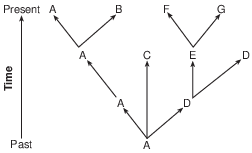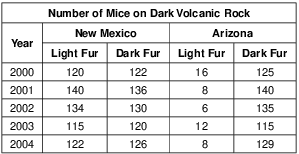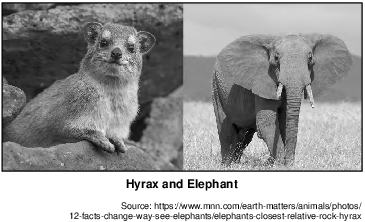Topic: Evolutionary Relationships And Cladogram
Evolutionary Relationships And Cladogram
According to the theory of biological evolution, most present-day species of organisms
(1) developed from similar, smaller prehistoric organisms
(2) have always existed in the form they have today
(3) developed from fossils of the other organisms
(4) descended from earlier, different species of organisms
Caffeine is a compound found in the seeds of many different plants, such as coffee beans, cola nuts, and cacao beans (the source of chocolate). The presence of this chemical in all three types of plants suggests that these plants
(1) inherited identical mutations
(2) share a common ancestry
(3) were exposed to the same type of radiation in the past
(4) were cloned from a caffeine plant
Scientists at Penn State have sequenced the DNA of the extinct woolly mammoth. The data suggested that the woolly mammoth was more closely related to present-day elephants than previously believed.

Which statement could account for the similarities between the woolly mammoth and present-day elephants?
(1) Common gene mutations were caused by agents such as industrial chemicals and radiation.
(2) Present-day species developed from earlier, different species.
(3) Selective breeding results in offspring better able to survive.
(4) Both animals have identical genetic information.
Fossil Footprints
Scientists examined a trail of fossil footprints left by early humans in soft, volcanic ash in Eastern Africa. A drawing of the trail of footprints is shown below. Each footprint is represented as a series of lines indicating the depth that different parts of the foot sank into the volcanic ash.

The type of information directly provided by these fossil footprints is useful because it
(1) offers details about how these individuals changed during their lifetime
(2) offers data regarding their exposure to ultraviolet (UV) radiation
(3) is a record of information about what these individuals ate during their lifetime
(4) is a record of some similarities and differences they share with present-day species
In 2007, scientists broke open a fossil of a dinosaur bone and found some preserved tissues. Analysis showed that some proteins in these tissues are very similar to proteins found in modern chickens. The conclusion that these dinosaurs are related to modern chickens is based on
(1) molecular similarities
(2) natural selection
(3) similarities in behavior
(4) the occurrence of mutations
Evidence that best supports the theory of biological evolution was obtained from the
(1) investigation of environmental niches
(2) study of fossil records
(3) comparison of the number of cells in organisms
(4) analysis of food chains and food webs
Natural selection and its evolutionary consequences provide a scientific explanation for
(1) the fossil record of ancient life-forms
(2) predictions about the rate of global warming
(3) the amount of precipitation in a rain forest
(4) the amount of soil used to grow certain crops
Scientists who have examined the fossil record have noted that some species have changed very little over long periods of geologic time. The lack of change in such organisms is most likely because
(1) all members of their population were genetically identical, and they lived in a rapidly changing environment
(2) there was a large amount of variation in their population, and the environment changed frequently
(3) they could move between different environ- ments when food supplies became scarce
(4) the environment that they lived in remained the same, and they were well-adapted to it
The fossil record of ancient life forms provides scientific evidence of
(1) direct harvesting
(2) selective breeding
(3) gene manipulation
(4) evolutionary changes

Identify one type of molecular evidence that could have been used to determine the evolutionary relationships illustrated in the diagram. [1]
Allow 1 credit. Acceptable responses include, but are not limited to:
• — amino acid sequences
• — DNA/gene sequence
• — the results of a gel electrophoresis test
• — gene sequences
• — the results of a paper chromatography test
Pocket Mice
Pocket mice are small rodents that feed mainly at night and are preyed upon by owls, hawks, and snakes. Scientists studied pocket mice living on dark volcanic rock in both New Mexico and fifty miles away in Arizona. They recorded their data in the chart below.

Dark fur color in pocket mice is the result of a mutation. Scientists analyzed the sequence of bases in the gene known to play a role in fur color and discovered that the mutation was identical in both the New Mexico and Arizona mouse populations. Explain how it is possible for these two different populations to have identical gene sequences for dark fur color. [1]
Allow 1 credit. Acceptable responses include, but are not limited to:
• — The mice in the two populations evolved from the same ancestral population.
• — They evolved from a common ancestor.
• — The same mutation occurred in both populations.
• — Some of the mice migrated.
• — They are members of the same species.
• — The populations interbred.
Bye – Bye Bananas?
The world’s most popular type of banana is facing a major health crisis. According to a new study, a disease caused by a powerful fungus is killing the Cavendish banana, which accounts for 99% of the banana market around the globe. The disease, called tropical race 4 (TR4), has affected banana crops in southeast Asia for decades. In recent years, it has spread to the Middle East and the African nation of Mozambique. Now experts fear the disease will show up in Latin America, where the majority of the world’s bananas are grown. …
…Once a banana plant is infected with TR4, it cannot get nourishment from water and nutrients, and basically dies of thirst. TR4 lives in soil, and can easily end up on a person’s boots. If the contaminated boots are then worn on a field where Cavendish bananas are grown, the disease could be transferred. “Once a field has been contaminated with the disease, you can’t grow Cavendish bananas there anymore,” Randy Ploetz [scientist] says. “The disease lasts a long time in the soil.”…
…But Cavendish [banana] is also particularly vulnerable to TR4. The banana is grown in what is called monoculture. “You see a big field of bananas and each one is genetically identical to its neighbor” Ploetz says. “And they are all uniformly susceptible to this disease. So once one plant gets infected, it just runs like wildfire throughout that entire plantation.”…
Source: http://www.timeforkids.come/new/bye-bye-bananas/3311666
Explain why the entire Cavendish banana crop worldwide is particularly vulnerable to the TR4 fungus. [1]
Allow 1 credit. Acceptable responses include, but are not limited to:
• — All of the banana plants are genetically identical.
• — There is no diversity among the most common type of bananas that people consume.
• — Without genetic variation, the banana plants are more likely to be killed by the fungus.
• — The crop is grown in monoculture, so all plants are susceptible.
• — The fungus is easily transferred.
A Close Relative of the Elephant
A hyrax is an animal that has been called a rock rabbit and looks like a guinea pig. Fossil records show that hyraxes first appeared on Earth approximately 37 million years ago. As they evolved, some became mouse-sized, while some were the size of a horse. Some eventually adapted to marine life and are related to manatees, and some became grazers and are related to elephants.

Identify one type of molecular evidence that could have been used to develop this mammalian evolutionary tree, and describe one specific way that the evidence could have been used to construct the tree. [1]
Evidence: ________________________________________
Allow 1 credit. Acceptable responses include, but are not limited to:
• Evidence: DNA
• — The more similar the DNA codes of organisms are, the closer the organisms will be on the
• tree.
• Evidence: Similar proteins
• — If organisms produce several similar proteins, they are likely to be closely related and closer
• on the evolutionary tree.
• Evidence: Amino acid sequences
• — The more amino acid sequences that are the same in two organisms, the more closely related
• they are.
Most animal fossils include hard body parts such as teeth and bones. Until recently, scientists had little hope that soft tissue could be preserved in the bones. A team of scientists has removed soft tissue containing a collagen protein from the leg bone of a 68-million-year-old fossil from a dinosaur, Tyrannosaurus rex. The technique of mass spectrometry was used to identify the sequences of certain molecules in several small fragments of the dinosaur collagen protein.
The molecular sequences were compared to those of modern animals. The scientist found that the collagen protein of the Tyrannosaurus rex more closely resembled the collagen protein found in modern chickens than that in some other modern animals.
State one kind of evidence that would support the conclusion that birds evolved from dinosaurs like Tyrannosaurus rex. [1]
Allow 1 credit. Acceptable responses include, but are not limited to:
• — The collagen protein of Tyrannosaurus rex more closely resembles the collagen protein of
• chickens than other animals.
• — similar bone structures
• — Similar proteins were identified in both.
New varieties of organisms have resulted from human activities. These organisms have often led to problems in modern society. Two of these new varieties are listed below.
Antibiotic-resistant bacteria Pesticide-resistant insects
Select one of these varieties and discuss a problem associated with the development of this new variety of organism. In your answer, be sure to:
• identify the variety you selected
• identify one biological process by which a population of this variety may develop resistance [1]
• describe how this process is involved in the production of a population of resistant organisms [1]
• identify one problem caused by this resistance [1]
• state one solution to this problem [1]
• identify one possible negative effect of this solution [1]
Variety: ________________________________
The student’s response to the bulleted items in the question need not appear in the following order.
• 15 Allow 1 credit for identifying one biological process by which a population of this variety may develop resistance. Acceptable responses include, but are not limited to:
• — natural selection
• — evolution
• — reproduction
• — mutation
• 16 Allow 1 credit for describing how this process is involved in the production of a population of resistant organisms. Acceptable responses include, but are not limited to:
• Natural Selection:
• — The population had some members that were naturally resistant to antibiotics. They survived and reproduced, passing on the resistance.
• Evolution:
• — Some organisms were resistant to the pesticide. They survived and passed on the trait.
• Reproduction:
• — Resistant members survived and passed on the trait.
• Mutation:
• — It produces variations that give some organisms a survival advantage.
• Note: Allow credit for a response consistent with the process identified in question 15 .
• 18 Allow 1 credit for identifying one problem caused by this resistance. Acceptable responses include, but are not limited to:
• — Resistant bacteria will survive and continue to make people sick.
• — Insects will continue to destroy crops.
• — Antibiotics do not work anymore.
• — There will be less food available.
• 19 Allow 1 credit for stating one solution to this problem. Acceptable responses include, but are not
• limited to:
• — Do not use antibiotics/antibacterial products unless needed.
• — Use different antibiotics or pesticides.
• — Use a natural predator for pests.
• — Insert genes into plants that will make them resistant to bacteria or pests.
• — Research and find new antibiotics/ways of controlling insect pests.
• Note: Allow credit for a response consistent with the problem identified in question 18 .
• 21 Allow 1 credit for identifying one possible negative effect of this solution. Acceptable responses include, but are not limited to:
• — People might be sick longer.
• — More people could get sick.
• — Organisms may become resistant to other treatments.
• — Natural predators may get out of control.
• — Inserted genes may have an undesired effect.
• — Research takes a lot of time and money.
• Note: Allow credit for a response consistent with the student’s solution to question 19 .
